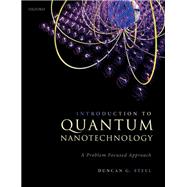
Introduction to Quantum Nanotechnology A Problem Focused Approach
by Steel, Duncan G.Buy New
Rent Textbook
Rent Digital
Used Textbook
We're Sorry
Sold Out
How Marketplace Works:
- This item is offered by an independent seller and not shipped from our warehouse
- Item details like edition and cover design may differ from our description; see seller's comments before ordering.
- Sellers much confirm and ship within two business days; otherwise, the order will be cancelled and refunded.
- Marketplace purchases cannot be returned to eCampus.com. Contact the seller directly for inquiries; if no response within two days, contact customer service.
- Additional shipping costs apply to Marketplace purchases. Review shipping costs at checkout.
Author Biography
Duncan Steel, Professor of Electrical Engineering and Computer Science, Professor of Physics, University of Michigan
Duncan G. Steel, The Robert J. Hiller Professor, Professor of Electrical Engineering and Computer Science, Professor of Physics, The University of Michigan - Ann Arbor. PhD in 1976 in Electrical and Nuclear Science, University of Michigan. Guggenheim Fellow (1999), APS Isakson Prize (2010), Elected Fellow of APS, OSA, and IEEE. 10 years at Hughes Research Laboratories (senior staff physicist), faculty at the University of Michigan (1985-), Area Chair for Optics and Director of the Optical Sciences Laboratory 1988-2007, Director of Biophysics 2007-2009.
Table of Contents
Chapter 1. Introduction to Applied Quantum Mechanics - Why quantum behavior is impacting technology.
Chapter 2. Nano Mechanical Oscillator and Basic Dynamics: Part I
2.1. Introduction
2.2. The Classical Approach: Finding
2.3. The Quantum Approach: Finding
2.4. Is it Classical or Quantum?
2.5. What is Knowable in a Quantum System?
2.6. Coherent Superposition States and Coherent Dynamics
2.7. The Particle and the Wave
2.8. Summary
Chapter 3. Free Particle, Wave Packet and Dynamics, Quantum Dots and Defects/Traps Scattering and Transport.
3.1. Introduction
3.2. The Free Particle
3.3. Localized State in Free Space: The Wave Packet
3.4. Nano-Heterostructures: Quantum Dots and Deep Traps
3.5. A Particle Trapped in a Shallow Defect
3.6. A Particle Trapped in a Point Defect Represented by a Dirac Delta-Function Potential
3.7. Physical Interpretation of the Dirac -function potential
3.8. Summary
Chapter 4. Periodic Hamiltonians and the Emergence of Band Structure: The Bloch Theorem and the Dirac Kronig-Penney model.
4.1. Introduction
4.2. The Translation Operator
4.3. Crystals and Periodic Potentials: The Bloch Theorem and the Dirac Kronig-Penney Model
4.4. Summary
Chapter 5. Scattering, Quantum Current, and Resonant Tunneling
5.1. Introduction
5.2. Scattering
5.3. Tunneling Through a Repulsive Point Defect Represented by a Dirac -Function Potential
5.4. Resonant Tunneling
5.5. Summary
Chapter 6. Bound States in 3-dimensions: The Atom.
6.1. Introduction
6.2. The Hydrogenic Atom
6.3. Summary
Chapter 7. The New Design Rules for Quantum: The Postulates.
7.1. Introduction
7.2. The Postulates of Quantum Mechanics
7.3. The Heisenberg Uncertainty Principle: The Minimum Uncertainty State
7.4. Interpreting the Expansion Coefficients: Relating Functional Form to Dirac Form
7.5. Summary
Chapter 8. Heisenberg Matrix Approach: Nano-Mechanical Oscillator and the Quantum LC Circuit.
8.1. Introduction
8.2. Heisenberg or Matrix Approach to Solving the Time Independent Schr?dinger Equation
8.3. Matrix Representation of Operators and Eigenvectors in Quantum Mechanics
8.4. The Quantum LC Circuit
8.5. Summary
Chapter 9. Quantum Dynamics: Rabi Oscillations and Quantum Flip-Flops.
9.1. Introduction
9.2. Time Evolution Operator
9.3. The Heisenberg Picture of Dynamics
9.4. The Interaction Picture
9.5. A Quantum Flip-Flop: Coherent Control of a Two-Level System and Rabi Oscillations
9.6. Summary
Chapter 10. The Quantum Gyroscope: The Emergence of Spin.
10.1. Introduction
10.2. Angular Momentum with the Heisenberg Approach
10.3. Intrinsic Angular Momentum: Spin
10.4. The Bloch Sphere and Spin
10.5. Addition of Angular Momentum
10.6. Angular Momentum and the Rotation Operator
10.7. Summary
Chapter 11. Time Independent and Time Dependent Perturbation Theory.
11.1. Introduction
11.2. Time Independent Perturbation Theory.
11.3. Time Dependent Perturbation Theory: Fermi's Golden Rule
11.4. Summary
Chapter 12. Bosons and Fermions: Indistinguishable particles with intrinsic spin.
12.1. Introduction
12.2. Eigenfunctions and Eigenvalues of the Exchange Operator
12.3. The Exchange Symmetry Postulate: Bosons and Fermions
12.4. The Heitler-London Model
12.5. Summary
Chapter 13. Quantum Measurement and Entanglement: Wave-Function Collapse
13.1. Introduction
13.2. Quantum Measurement
13.3. Quantum Entanglement and the Impact of Measurement
13.4. Quantum Teleportation
13.5. Summary
Chapter 14. Loss and Decoherence: The RLC Circuit
14.1. Introduction
14.2. Coupling to a Continuum of States: The Weisskopf-Wigner Approximation
14.3. Decay in the Nano-Vibrator Problem
14.4. The RLC Circuit
14.5. Summary
Chapter 15. The Quantum Radiation Field: Spontaneous Emission and Entangled Photons
15.1. Introduction
15.2. Finding the Hamiltonian for the Transverse Electromagnetic Field
15.3. Quantizing the Field
15.4. Spontaneous Emission
15.5. The Effects of the Quantum Vacuum on Linear Absorption and Dispersion
15.6. Rabi Oscillations in the Vacuum: The Jaynes Cummings Hamiltonian
15.7. Summary
Chapter 16. Atomic Operators
16.1. Introduction
16.2. Defining the Atomic Operators
16.3. The Physical Meaning of the Atomic Operators
16.4. The Atomic Operators in the Heisenberg Picture
16.5. The Exact Solution for the Atomic Operators for a Monochromatic Field
16.6. The Operator Equations of Motion Including Spontaneous Emission
Chapter 17. Quantum Electromagneticst
17.1. Introduction
17.2. The Number State Representation
17.3. The Coherent State
17.4. Quantum Beam Splitter: Quantum Interference
17.5. Resonant Rayleigh Scattering: A Single Quantum Emitter
17.6. Creating a Quantum Entangled State Between a Photon and an Electron
17.7. Engineering the Quantum Vacuum
17.8. Summary
Chapter 18. The Density Matrix: Bloch Equations
18.1. Introduction
18.2. The Density Matrix Operator
18.3. The Density Matrix Equations Including Relaxation
18.4. Solving the Reduced Density Matrix for a Two-Level System in the Presence of Resonant Classical Electromagnetic Field
18.5. Rate Equation Approximation
18.6. The Three-Level System: Emerging Importance in Quantum Technology
18.7. Summary
Appendices
A. Essential Mathematics Review
B. Power Series for important Functions
C. Properties and Representations for the Dirac Delta Function
D. Vector Calculus and Vector IdentifiesThe Electromagnetic Hamiltonian and the G?pert-Mayer Transformation
E. The Electromagnetic Hamiltonian and the G?pert-Mayer Transformation
F. Maxwell's Equations in Media, the Wave Equation and Coupling to a two-level system
G. Wigner-Eckart Theorem for evaluating matrix elements.
An electronic version of this book is available through VitalSource.
This book is viewable on PC, Mac, iPhone, iPad, iPod Touch, and most smartphones.
By purchasing, you will be able to view this book online, as well as download it, for the chosen number of days.
Digital License
You are licensing a digital product for a set duration. Durations are set forth in the product description, with "Lifetime" typically meaning five (5) years of online access and permanent download to a supported device. All licenses are non-transferable.
More details can be found here.
A downloadable version of this book is available through the eCampus Reader or compatible Adobe readers.
Applications are available on iOS, Android, PC, Mac, and Windows Mobile platforms.
Please view the compatibility matrix prior to purchase.
